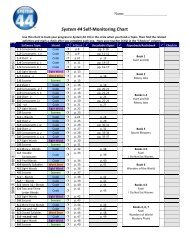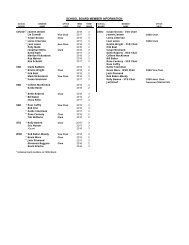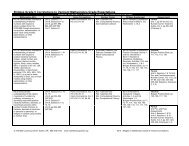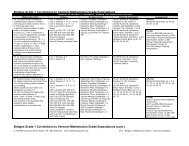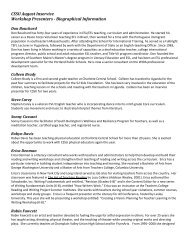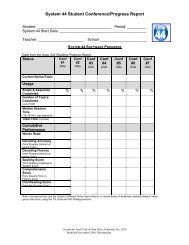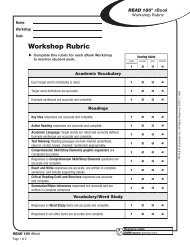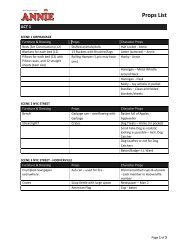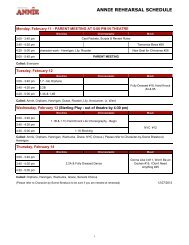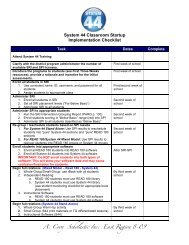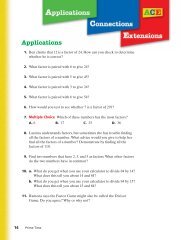Domain #1 – Planning and Preparation Danielson's Framework for ...
Domain #1 – Planning and Preparation Danielson's Framework for ...
Domain #1 – Planning and Preparation Danielson's Framework for ...
You also want an ePaper? Increase the reach of your titles
YUMPU automatically turns print PDFs into web optimized ePapers that Google loves.
<strong>Domain</strong> <strong>#1</strong> <strong>–</strong> <strong>Planning</strong> <strong>and</strong> <strong>Preparation</strong> Danielson’s <strong>Framework</strong> <strong>for</strong> Teaching<br />
ELEMENT<br />
Knowledge of<br />
Characteristics of Age<br />
Group<br />
Component 1b: Demonstrating Knowledge of Students<br />
LEVEL OF PERFORMANCE<br />
UNSATISFACTORY BASIC PROFICIENT DISTINGUISHED<br />
Teacher displays minimal<br />
knowledge of developmental<br />
characteristics of age group.<br />
Teacher displays generally<br />
accurate knowledge of<br />
developmental characteristics of<br />
age group.<br />
Teacher displays thorough<br />
underst<strong>and</strong>ing of typical<br />
developmental characteristics of<br />
age group as well as exceptions to<br />
general patterns.<br />
Teacher displays knowledge of<br />
typical developmental<br />
characteristics of age group,<br />
exceptions to the patterns, <strong>and</strong> the<br />
extent to which each student<br />
follows patterns.<br />
Knowledge of Students’<br />
Varied Approaches to<br />
Learning<br />
Teacher is unfamiliar with the<br />
different approaches to learning<br />
that students exhibit, such as<br />
learning styles, modalities, <strong>and</strong><br />
different “intelligences.”<br />
Teacher displays general<br />
underst<strong>and</strong>ing of the different<br />
approaches to learning that<br />
students exhibit.<br />
Teacher displays solid<br />
underst<strong>and</strong>ing of the different<br />
approaches to learning the<br />
different students exhibit.<br />
Teacher uses, where appropriate,<br />
knowledge of students’ varied<br />
approaches to learning in<br />
instructional planning.<br />
Knowledge of Students’<br />
Skills <strong>and</strong> Knowledge<br />
Teacher displays little knowledge<br />
of students’ skills <strong>and</strong> knowledge<br />
<strong>and</strong> does not indicate that such<br />
knowledge is valuable.<br />
Teacher recognizes the value of<br />
underst<strong>and</strong>ing students’ skills <strong>and</strong><br />
knowledge but displays this<br />
knowledge <strong>for</strong> the class only as a<br />
whole.<br />
Teacher displays knowledge of<br />
students’ skills <strong>and</strong> knowledge <strong>for</strong><br />
groups of students <strong>and</strong> recognizes<br />
the value of this knowledge.<br />
Teacher displays knowledge of<br />
students’ skills <strong>and</strong> knowledge <strong>for</strong><br />
each student, including those with<br />
special needs.<br />
Knowledge of students’<br />
interests <strong>and</strong> cultural<br />
heritage<br />
Teacher displays little knowledge<br />
of students’ interests or cultural<br />
heritage <strong>and</strong> does not indicate that<br />
such knowledge is valuable.<br />
Teacher recognizes the value of<br />
underst<strong>and</strong>ing students’ interests<br />
or cultural heritage but displays<br />
this knowledge <strong>for</strong> the class only<br />
as a whole.<br />
Teacher displays knowledge of<br />
the interests or cultural heritage of<br />
groups of students <strong>and</strong> recognizes<br />
the value of this knowledge.<br />
Teacher displays knowledge of<br />
the interests or cultural heritage of<br />
each student.



